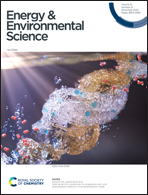Comment on “Zinc/selenium conversion battery: a system highly compatible with both organic and aqueous electrolytes” by Z. Chen, F. Mo, T. Wang, Q. Yang, Z. Huang, D. Wang, G. Liang, A. Chen, Q. Li, Y. Guo, X. Li, J. Fan and C. Zhi, Energy Environ. Sci., 2021, 14, 2441
Abstract
Chen et al. reported a zinc/selenium conversion battery that delivers a high discharge working voltage of about 1.15 V. However, fundamentally, the discharge voltage of the Zn–Se cell based on the conversion reaction between Se and ZnSe cannot be over 0.71 V according to the Gibbs free energies of ZnSe. Moreover, we are troubled by the data presented in Fig. S11, S14 and S23, which exhibit colored polyselenides in the Zn(TFSI)2 dissolved electrolyte. According to previous reports and our experimental results, we verify that their explanations and core conclusions are inconsistent with the data presented by the author. Finally, we find that the main contribution of capacity and voltage actually comes from the conversion reaction between ZnSe and Se(TFSI)4.



 Please wait while we load your content...
Please wait while we load your content...